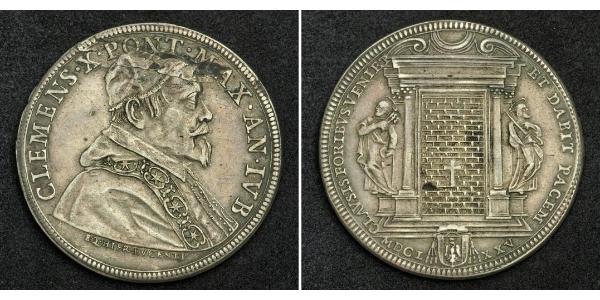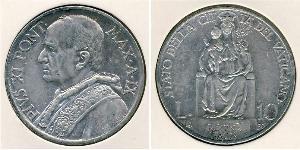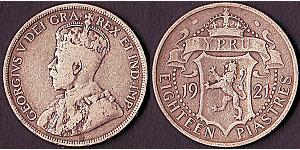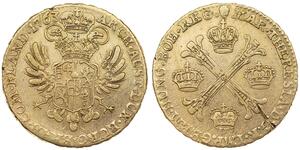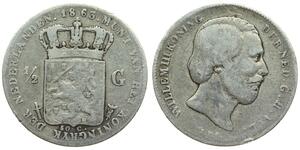(售价 $527.0)
1675, Vatican, Pope Clement IX. Large Silver Piastra (80 Bolognini) Coin. RR!
Mint Place: Rome
Engraver: T. Mercandetti
Mint Year: 1795 (ANNO XXI)
Mint master: Cavalier Gerolamo Lucenti
Denomination: Piastra (Scudo of 80 Baiocchi)
Reference: Davenport 4079, CNI XVI 29, Muntoni 12, Berman 2003, KM-369 ($700 in VF / $1350 in XF!). RR!
Condition: Struck on a defective planchet with a lamination defect in obverse and small gap in reverse, otherwise a nice XF-AU with nice grey toning!
Weight: 31.82gm
Diameter: 44mm
Material: Silver
Obverse: Tiara and crossed tasseled keys above quartered shield with family arms of the pope within foliage.
Legend: CLEMENS. X. PONT. MAX. AN. IV B
Exergue: EQ. HIER. LVCENTI (Cavalier Gerolamo Lucenti)
Reverse: Closed Holy Door, flanked by statues of Saint Peter and Saint Paul.
Legend: CLAVSIS. FORIBVS. VENIET - ET. DABIT. PACEM ("When the doors are opened, he will come and give peace!")
Exergue: MDCL (coat of arms Imperiali) XXV.
Each of the four papal basilicas in Rome has a holy door (porta santa in Italian and porta sancta in Latin). The doors are normally sealed shut from the inside so that they cannot be opened. They are opened during Jubilee years, when pilgrims enter through those doors to gain the plenary indulgence connected with the Jubilee.
It was formerly supposed that this rite was instituted by Pope Alexander VI in the Jubilee of 1500, but this is certainly a mistake. Not to speak of a supposed vision of Pope Clement VI as early as 1350, who is said to have been supernaturally admonished to "open the door", there are several references to the "holy door" or the "golden gate" in connection with the Jubilee long before the year 1475. The earliest account seems to be that of the Spanish pilgrim, Pero Tafur, c. 1437. He connects the Jubilee indulgence with the right of sanctuary, which, he maintains, existed in pagan times for all who crossed the threshold of the puerta tarpea upon the site of the Lateran. He goes on to say that, at the request of Constantine, Pope Sylvester I published a Bull proclaiming the same immunity from punishment for Christian sinners who took sanctuary there. The privilege, however, was grossly abused, and the Popes consequently ordered the door to be walled up at all seasons except during certain times of special grace. Formerly the door was unwalled only once in a hundred years, this was afterwards reduced to fifty, and now it is said to be "opened at the will of the Pope." However legendary all this may be, it is unlikely that the story could have been quite recently fabricated at the time Tafur recorded it. Moreover, a number of witnesses allude to the unwalling of the holy door in connection with the Jubilee of 1450. One of these, the Florentine merchant Giovanni Rucellai, speaks of the five doors of the Lateran basilica,
one of which is always walled up except during the Jubilee year, when it is broken down at Christmas when the Jubilee commences. The devotion which the populace has for the bricks and mortar of which it is composed is such that at the unwalling, the fragments are immediately carried off by the crowd, and the foreigners (gli oltremontani) take them home as so many sacred relics… Out of devotion every one who gains the indulgence passes through that door, which is walled up again as soon as the Jubilee is ended.
All this describes a rite which has lasted unchanged to the present day, and which has nearly always supplied the principal subject depicted upon the long series of Jubilee medals issued by the various Popes who have opened and closed the holy door at the beginning and end of each Jubilee year. Each of the four basilicas has its holy door. That of St. Peter's is opened on the Christmas Eve preceding the anno santo by the pontiff in person, and it is closed by him on the Christmas Eve following, using a special ornamental trowel to put the first bit of concrete. Until the Great Jubilee of 2000, the Pope knocked upon the door three times with a silver hammer, singing the versicle "Open unto me the gates of justice". The masonry, which had been loosened beforehand, was made to fall in at the third blow. After the threshold was swept and washed by the Jubilee penitentiaries, the Pope entered first. Each of the holy doors at the other basilicas is similarly opened by a cardinal specially deputed for the purpose. The symbolism of this ceremony is probably closely connected with the idea of the exclusion of Adam and Eve from Paradise, and the expulsion and reconciliation of penitents according to the ritual provided in the Pontifical. But it may also have been influenced by the old idea of seeking sanctuary, as Tafur and Rucellai suggest. The sanctuary knocker of Durham Cathedral still remains to remind us of the important part which this institution played.
Pope John Paul II simplified the ceremony for the Great Jubilee of 2000 for safety reasons; previously, debris had fallen on Pope Paul VI while striking down the door. Workers had removed the concrete before the ceremony of the opening of the door so that the Pope only had to push on the doors with his hands. The holy door of St. Peter's Basilica was opened by the Pope on 24 December 1999 while the doors of St. John Lateran and St. Mary Major were opened on 25 December and 1 January, respectively. Breaking with tradition, the Pope opened both of these personally, rather than delegating this to a cardinal. The doors of Basilica of Saint Paul Outside the Walls were opened in an ecumenical ceremony on 18 January, first day of the World Week of Prayer for Christian Unity by the Pope, the Archbishop of Canterbury and a representative of the Ecumenical Patriarch. The door in St. Peter's was closed on 6 January 2001, with the others being closed one day earlier.
Above the holy door in St. Peter's are marble memorial plates commemorating the last two times that the door has been opened. Since John Paul II held the last two Jubilees, both plates indicate that he opened and closed the door.
Pope Clement IX (28 January 1600 – 9 December 1669), born Giulio Rospigliosi, was Pope from 1667 to 1669.
Born Giulio Rospigliosi to a noble family of Pistoia, Grand Duchy of Tuscany, he was a pupil of the Jesuits. After receiving his doctorate in philosophy at the University of Pisa, he taught theology there. Later Rospigliosi worked closely with Pope Urban VIII (1623–1644), a Barberini Pope, where he worked in the Papal diplomacy as nuncio to Spain, among other posts. He was also made vicar of Santa Maria Maggiore in Rome.
Rospigliosi was an accomplished man of letters, who wrote poetry, dramas and libretti, as well as what may be the first comic opera[citation needed]. He was also a patron of Nicolas Poussin, commissioning A Dance to the Music of Time from him and dictating its iconography.
During the reign of Pope Innocent X (1644–55), who was hostile to the Barberini and their adherents, Rospigliosi continued his appointment as papal nuncio to the court of Spain. After the accession of Pope Alexander VII (1655–67), he once again enjoyed papal favour. In 1657 he was named Cardinal-Priest of San Sisto and Secretary of State. After Alexander VII's death in 1667, an 18-day papal conclave concluded with Rospigliosi's election as Pope. Upon his succession, he took the name Clement IX.
Nothing remarkable occurred under Clement IX's short administration beyond the temporary adjustment of the disputes between the Holy See and those prelates of the Gallican Church who had refused to join in condemning the writings of Jansen. He was mediator during the 1668 peace of Aachen, in the wars of succession between France, Spain, England and the Netherlands.
As Pope, Clement IX continued his interest in the arts. He embellished the city of Rome with famous works commissioned to Gian Lorenzo Bernini, including the angels of Ponte Sant'Angelo and the colonnade of Saint Peter's Basilica. Somewhat unusually for Popes of the era, Clement IX did not have his name displayed on monuments he built. He also opened the first public opera house in Rome[citation needed], and for the Carnival celebrations of 1668, commissioned Antonio Maria Abbatini of the Sistine Chapel Choir to set to music his free Italian translation of a Spanish religious drama La Baltasara. The production had sets designed by Bernini.
Clement IX worked to strengthen Venetian defences against the Turks on the island of Crete. However, he was unable to get wider support for this cause. At the end of October 1669 Clement IX fell ill after receiving news that the Venetian fortress of Candia in Crete had surrendered to the Turks. He died in Rome, allegedly of broken heart, in December of that year. His successor, Pope Clement X (1670–1676), built him an ornate tomb in Santa Maria Maggiore.
Only 1$ shipping for each additional coin purchased!
1/2 Kronenthaler 荷兰 銀
本组有 9 钱币 / 8 售价
⇑
50 Cent / 1/2 Gulden 荷兰王国 銀 威廉三世 (尼德兰)
本组有 13 钱币 / 13 售价
⇑

